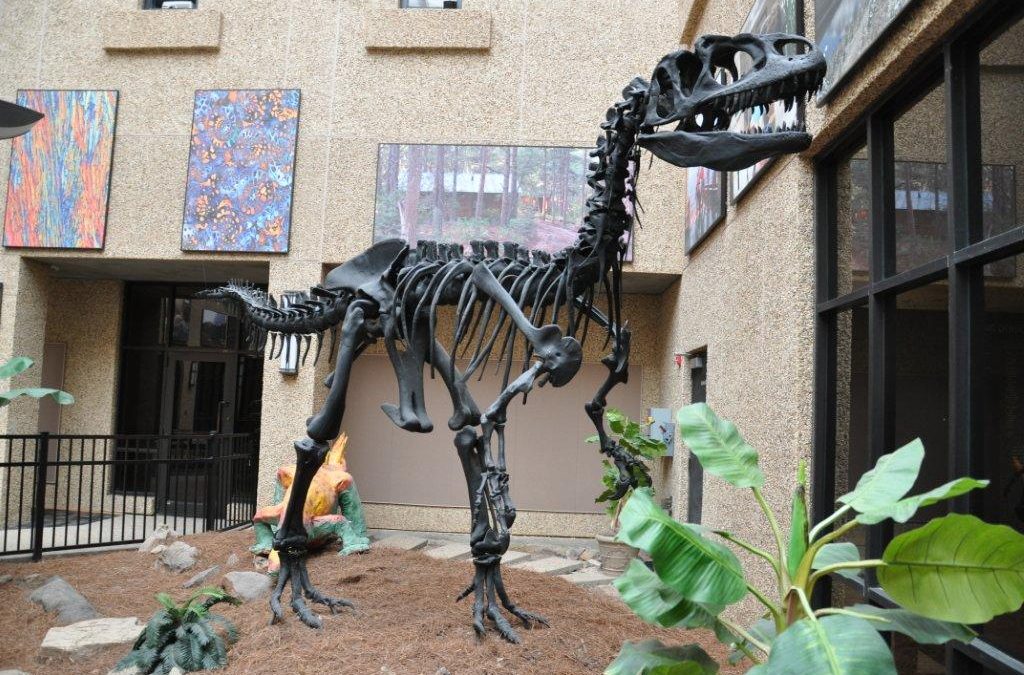
by admin | Feb 1, 2012 | Cajun Country, Greater Baton Rouge
Louisiana is not known for dinosaurs – that much I have learned through my Internet searching. Now Wyoming, Colorado and the Dakotas, they’re a different story. Unfortunately the pleads of a three-year-old are not compelling enough to make me drive 26 hours to view a bunch of skeletons. Lucky for him, and the rest of our family, the Lafayette Science Museum is featuring the American Museum of Natural History’s traveling “Dinosaurs” exhibit.
 |
| T-Rex on display at the Lafayette Science Museum |
The drive is still a bit much to make without stopping, so we planned a layover at a friend’s house in Baton Rouge. While in town, we couldn’t pass up a glimpse of LSU’s Mike the Tiger, and the trip to campus reminded us of old anthropology classes in the Howe Russell building and the fossils and rocks on display there.
 |
| LSU’s allosaurus skeleton |
It promised to be a great “starting off” site for our dinosaur adventures, but when we entered the front doors, Charles nearly squealed with delight at the sight before us. Although the child can’t read, he instantly spouted out that this skeleton on display was “an allosaurus – a carnivore that walked on two feet and had three fingers, not two like T-Rex.” (I must say, I will never understand his obsession with the fingers.) The discovery kept us occupied for quite some time, and Charles discussed the similarities and differences of dinosaurs in lengthy detail well into the night.
The next morning we moved on to Lafayette and headed into the heart of downtown. Our first stop was brunch at The French Press, where we gorged ourselves on the Cajun Benedict: toasted French bread, Hebert’s boudin and two poached-medium eggs topped with chicken and andouille gumbo and fresh scallions. Shortly after, we waddled across the Parc Sans Souci toward the Lafayette Science Museum.
 |
| Lafayette Science Museum |
While the planetarium is closed for a digital upgrade, the main attraction until March 11 is the “Dinosaurs: Ancient Fossils, New Discoveries” exhibit. The $5 tickets seemed like a bargain when we entered the far hall and came face to face with a giant T-Rex skeleton (complete with two fingers on each hand). He beckoned us inside to explore a life-sized steel and fiberglass apatosaurus, fossilized footprints and a diorama of eastern Asia as it looked 130 million years ago. After making two rounds through the displays, we grabbed some coloring sheets at the end and walked out the doors. I paused in confusion as we exited – what, no gift shop? Although a huge missed opportunity for the museum, it was a lifesaver for us, as gift shops almost always end in meltdowns.
 |
| Cypress trees at Lake Martin |
The afternoon’s adventures winded down with a short drive out into the countryside and a leisurely stroll through the Nature Conservancy’s Cypress Island Preserve at Lake Martin. A loop boardwalk and levee trail offered prime glimpses into the moss-covered, cypress tupelo swamp that serves as a bird haven in late spring. Sunsets are reportedly divine at this picturesque spot, and the lake comes to life when thousands of herons, egrets and roseate spoonbills make this their home during nesting season. The area was scarcely occupied when we visited, though, and I left with the impression that we had found a jewel tucked away inside the state.
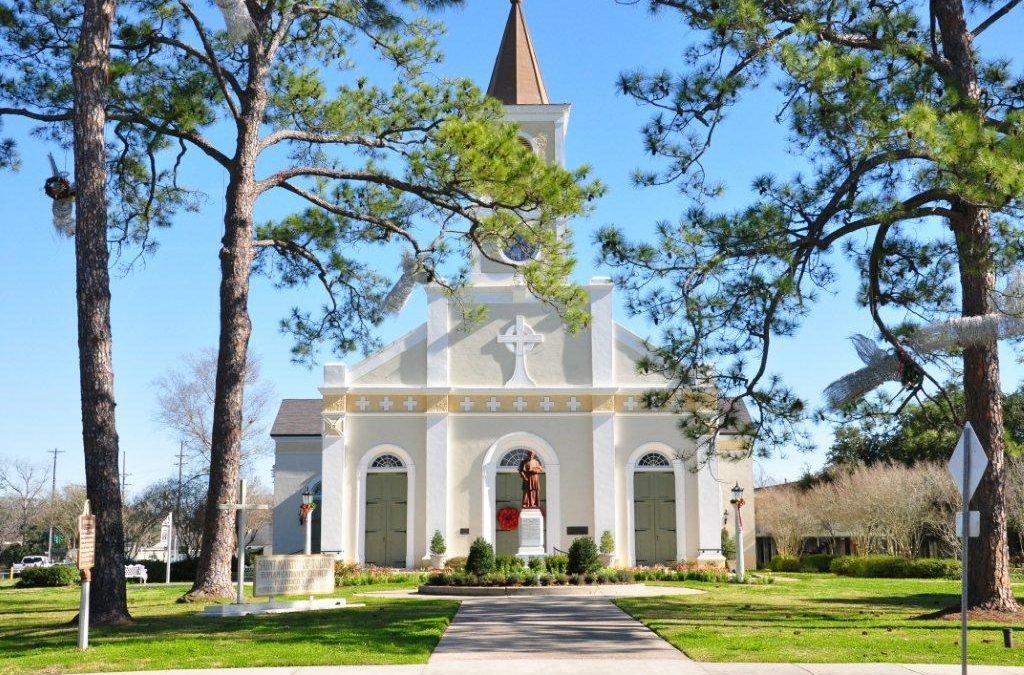
by admin | Jan 18, 2012 | Cajun Country, Most popular
On the eastern edge of Lafayette, a circle of roads connects the historic town of St. Martinville with picturesque Lake Fausse Pointe. This was our weekend destination, and we launched the adventure from the Crawfish Capitol of the World – Breaux Bridge. As we passed under the bridge and over Bayou Teche, the kids jolted from their naps and began fidgeting with anticipation.
 |
| Evangeline Oak in St. Martinville |
The sleepy downtown was filled with antique stores and the promise of amazing treasures, but one glance at the wild-eyed kiddos in back, and we continued south through the countryside to the equally charming town of St. Martinville. As Charles catapulted from the car, he was stopped in his tracks by our friend who had followed along on the trip. Shaking off his momentary confusion, he pulled her along in his quest for new discoveries in Louisiana’s third oldest town.
 |
| St. Martin de Tours Catholic Church in St. Martinville |
The ample grounds of St. Martin de Tours Catholic Church was the perfect location for running off some energy and adding to our rapidly growing collection of twigs. A man removing Christmas decorations drew us to the church’s front doors, and we ducked under his ladder to enter “the Mother Church of the Acadians” – descendants of the French colonists forced out of Nova Scotia during the French and Indian War. The strong smell of incense lingered in the air inside, encircling us as we toured the gated pews and colorful patterns reflecting on the floor from the stained-glass windows.
 |
| Le Petit Paris Cafe |
Before we could go any farther, we crossed the street for burgers and fries at Le Petit Paris Cafe. We were the only patrons in the quaint restaurant, which gave the kids free reign to squeal and play to their delight. The rest of the historic buildings are centered around the church, and we strolled past the Duchamp Opera House and La Maison Duchamp on our way to Bayou Teche and the Evangeline Oak. Immortalized by Longfellow’s poem “Evangeline,” the ancient oak is one of the most photographed spots in the state.
 |
| Cypress trees in Lake Fausse Pointe State Park |
From St. Martinville, we headed out Catahoula Highway past an intriguing oak and pine alley to the levee road that leads to Lake Fausse Pointe State Park. It was here that, after reuniting with some good friends and tearing both their children and ours away from the playground, we set off to discover nature. At one time part of the Atchafalaya Basin, the 6,000-acre park features both boardwalk and canoe trails through the watery home of alligators and bald cypress trees. Although the sounds of our nine-person group tromping through the forest scared away any signs of life, we couldn’t help but enjoy the fresh air and lovely scenery.
On the way out, we traveled the levee road back to I-10, where in the tiny town of Henderson, we enjoyed a seafood-filled dinner at Pat’s Fisherman Wharf. It was dark when we drove away with full bellies and memories of another Louisiana adventure.
 |
| Playing on a natural see-saw at Lake Fausse Pointe |
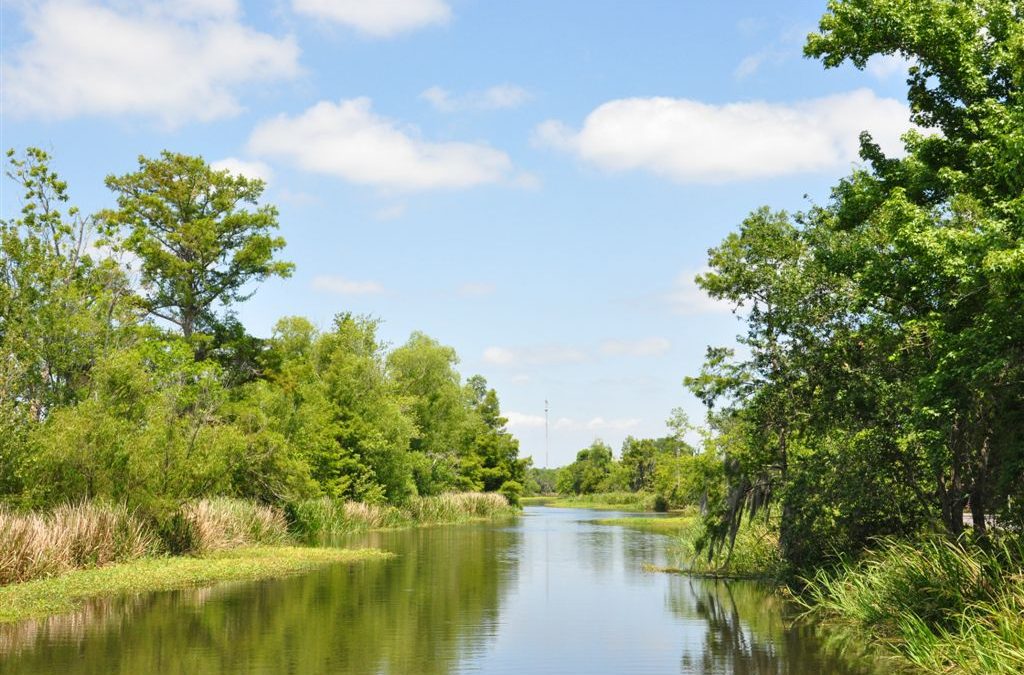
by admin | Jun 3, 2011 | Cajun Country
Amidst all the flooding concerns of late, towns in the path of the Morganza Spillway have garnered a lot of attention–including ours. Like all those people seen perched on the edge of the Bonnet Carre, we wanted to be part of the action, but certainly not too close. Houma seemed like a reasonable compromise, with homes sandbagged and lined with Tiger Dam, but actually no water in sight.
 |
| Southdown Plantation |
On the relatively quick drive down, I pulled out our guidebooks and started mapping out the day. Houma’s most famous landmark appeared to be Southdown Plantation, a pink and green, 19th century manor house that stands as a monument to the once booming sugar industry in Terrebonne Parish. Today the mansion is home to the Terrebonne Museum of history, culture and arts, as well as musician Tab Benoit’s Voice of the Wetlands festival every October. We’ve learned not to even attempt taking the kids on a house tour, but we did stretch our legs by walking the expansive yard, still searching for a cicada for Charles’ bug catcher.
Lunch at The French Loaf offered possibly the best poboys we’ve ever tasted–lightly fried seafood and fluffy, crisp bread. It was by chance that we stopped here, driving along Park Ave. searching for food. I even had second thoughts about going inside the non-descript, wooden shack, but I’m certainly glad we did.
 |
| Peacock at Wildlife Gardens |
Rejuvenated and ready to pick up our tour again, we drove Little Bayou Black Road, looking for more plantations and enjoying the rural scenery. Taking a detour onto Bull Run Road, we saw several people boarding a boat at Munson’s Swamp Tours and passed the entrance to Bois d’Arc Gardens, an iris garden open in March and April to visitors.
Looping around onto Bayou Black Road, we were headed to the Wildlife Gardens for a walking tour through a cypress swamp. We were expecting a more prominent entrance than the rustic signs pointing the way and a closed-up shop. Despite being a bed and breakfast, the gardens were empty of any humans, but several colorful peacocks beckoned us inside. A trail overtaken by large spiders led us past several cabins and around a small pond.
 |
| Trail through Wildlife Gardens |
After running into dead ends over several bridges, we were about to turn back when we spotted an enormous alligator inside a short, wire cage. Intimidated by the lack of protection separating us, we kept our distance while following the path around what turned out to be an alligator farm. Several more gators, each larger than the last, lay eerily still within the fencing, although we could feel them following us with their eyes. A trapper’s cabin stood at the far end of the trail, and a separate cage held more than a dozen frisky, hissing juvenile gators.
The hair on my neck rose as I finally realized we were carrying two small children, surrounded by these fierce creatures on a dark, wooded property that we were possibly trespassing on. Paul snapped one last picture, and we nearly ran out of the area, breathing a sigh of relief as we reached our car and the peacock perched in the tree above us.
 |
| Walking path and bridges along Bayou Terrebonne |
The rest of Bayou Black Road was tranquil and relaxing, and we made one last stop for a short hike at Mandalay National Wildlife Refuge before heading back into town. The day had become a scorcher and the kids were overdue for a nap, but I wanted to see the nicely landscaped park in front of the parish courthouse and the elegant path along Bayou Terrebonne. To complete the day, we picked up a basket of peaches from one of the fruit stands lining the road, dreaming of the peach and blueberry cobbler they soon would become.
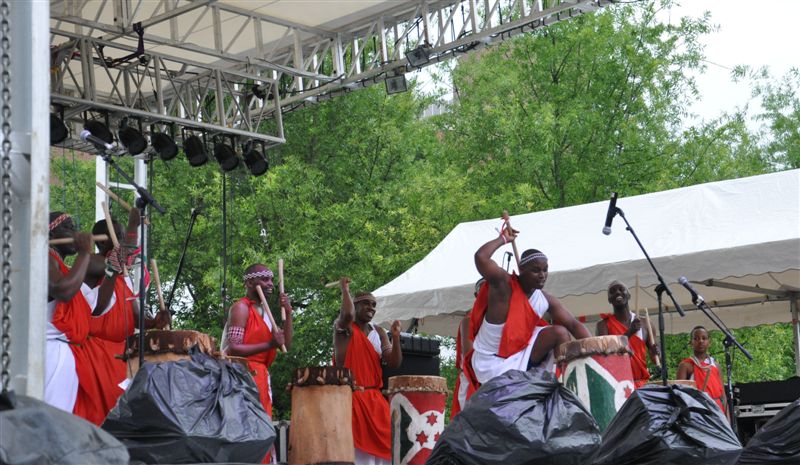
by admin | May 6, 2011 | Cajun Country
Every year during Jazz Fest, our neighbors are talking about another festival — the Festival International de Louisiane in downtown Lafayette. It didn’t take much convincing for us to get on the road and use this as our excuse to visit the heart of Cajun land.
Despite leaving work early, the four of us and half our house crawled out of the city in rush hour traffic only to sit in Metairie’s infamous traffic jam. I’ve tried my best to block out the evening’s travels, but I vaguely remember a lot of crying coming from two exhausted, yet stubbornly refusing-to-take-a-nap children. By the time we hit Baton Rouge, I swear the car stopped itself and kicked us out on the curb. The next 15 minutes were spent scarfing down Cane’s chicken fingers while our 9-month-old August played his favorite game of beating the table and his older brother Charles breakdanced across the floor.
 |
| Statue of Mike the Tiger at Louisiana State University |
Luckily, the evening wasn’t a complete wash. A quick stop to see LSU‘s Mike the Tiger paid off when the bengal tiger put on an elaborate show of racing around his cage and trying to climb a tree. And then, when dark set in and we got back on the road, our two little angels passed out. We pulled into our friends’ driveway in Carencro with a sigh of relief, plopping both kids in bed and settling down to visit with real adults while watching highlights of the Royal Wedding.
 |
| Musical instruments at the Acadian Cultural Center |
The next morning was overcast and drizzly so we decided to stop by an indoor spot before attempting the outdoor festival. The Acadian Cultural Center, Jean Lafitte National Park’s Lafayette site, details the history of the Acadians, many of whom settled in south Louisiana after being exiled from Nova Scotia. The French-speaking Acadians became today’s Cajuns, known world-wide for their food and music. A movie and extensive exhibits showcased their culture, while a reconstructed Cajun-Creole settlement sat down the road at Vermilionville. Time and weather didn’t permit us to visit the living history museum, but it certainly made my list for a future visit.
 |
| Dancing to the music |
Although it was still misting, we couldn’t prolong the festival anymore. Parking downtown, we grabbed our umbrellas and strollers (our friends had two small children as well) and went straight for the festival food, deciding on fried catfish served over rice and smothered in a spicy crawfish etouffee. With six music stages, countless arts and crafts booths, food courts and street musicians, the free-of-charge International Festival sprawls across the historic streets of downtown Lafayette. Musicians from around the world come to play at the five-day festival, and we saw everything from Native American flute players and African drummers to the next child star singing Cajun music. We eventually made our way to the well-hidden children’s section, which turned out to be an enormous fenced-in area with multiple playgrounds, piles of hoola hoops and giant bouncy balls, art activities, face painting and some of the best music at the festival.
 |
| Chretien Point plantation |
That evening, in anticipation of the next day’s activities, we treated ourselves to a second helping of crawfish — this time with pasta and delicious boudin from the local grocery store. On Sunday, we were in for a special treat. Our friend’s grandfather owns crawfish ponds in the neighboring town of Sunset, and we were going to take a ride in them. To reach the ponds, we passed Chretien Point plantation, built in 1831, often visited by Jean Lafitte the pirate and boasting a staircase made famous in “Gone with the Wind.”
 |
| A crawfish trap |
Unfortunately, it was closed for viewing, so we continued on to the ponds, where we boarded a handmade boat complete with wheels to churn through the mud. The kids marveled at the crawfish hanging out in the bottom of each trap and threw in food as we passed. As I write this blog, the scratching noise coming from my den reminds me of the souvenir crawfish Charles brought home as a pet reminder of our once in a lifetime experience.
As with all trips, we should have ended it there, but instead we decided to try out a new Mexican restaurant in town. With the arrival of the queso dip appetizer, Charles’ hungry fingers dragged the bowl closer — just in front of August’s face, whose chubby little hands took one swift moment to dump the entire contents all over himself. And so we bid farewell to our friends, promising to return again as we had so much more of the area to discover.
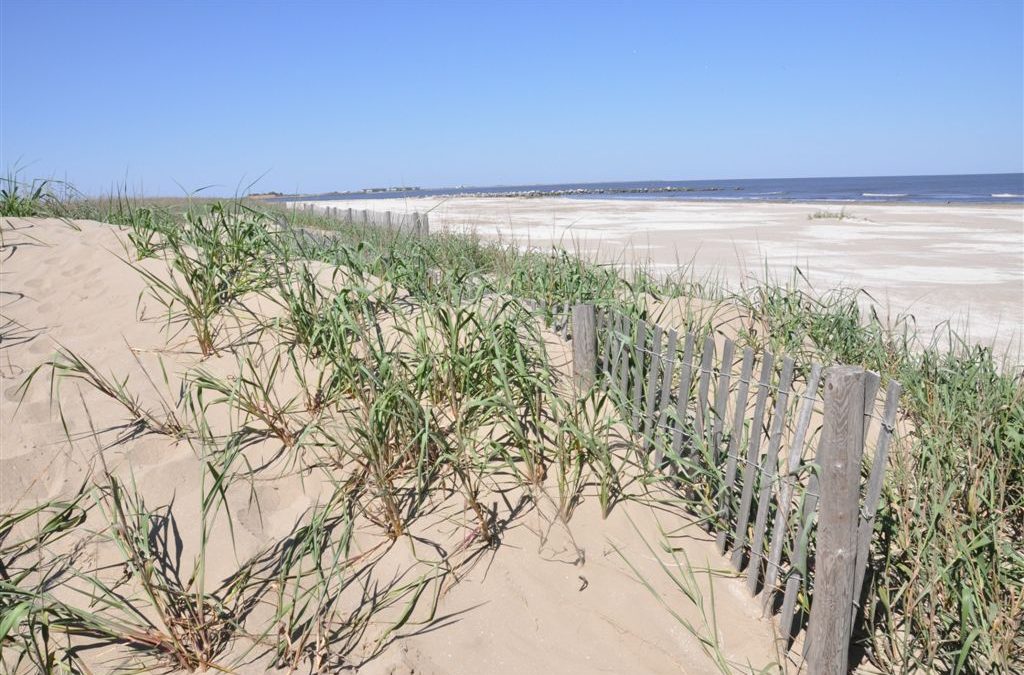
by admin | Apr 19, 2011 | Cajun Country
I’ll be the first to admit that I don’t know a blue jay from a bluebird, but experts and amateurs alike are welcome at the Grand Isle Migratory Bird Festival…at least that’s what my husband, Paul, told me while packing us up for a two-hour drive to Grand Isle. I was quite doubtful that our three-year-old would be welcome among groups of whispering, tip-toeing bird watchers, but I plugged in the portable DVD player and took out the map for the drive.
 |
| Pelicans skimming the ocean. |
There are two important things to know before you even get to Grand Isle: going one mile too fast will earn you a speeding ticket in Golden Meadow and the new, white bridge leading to the island is a toll bridge with no toll booth. Once you conquer these two obstacles, you emerge on a decent-sized island known for its fishing, birding and, of course, proximity to oil.
We picked up some poboys at the elevated deli near the beginning of the island and carried them over to the beach for a picnic lunch. The wind whipped in our face, blowing sand and our napkins across the parking lot, but Charles was oblivious while he marched off with bucket and shovel in hand. The beach here is not the fine white sand you find in Florida, but rather crushed shells packed tight into a solid surface. We soon found out there are other perks, though, as a dolphin playfully danced through the ocean right in front of us while dozens of brown pelicans skimmed the surface of the water searching for food.
 |
| Charles on his first fishing trip |
Finishing off lunch, we drove to the far end of the island to Grand Isle State Park. The park was free for the birding festival, but the beach was closed due to large amounts of tar balls showing up at the water’s edge. As we walked the length of the fishing pier, we gazed longingly at the finer, silky sand that was off-limits to visitors. Several weekend vacationers were manning fishing poles at the end of the T-shaped pier, and in the 20 minutes we watched, they pulled in four catfish and an enormous sting ray. Charles even got to guard a fishing pole while one kid left to drop his latest catch in the ice chest.
 |
| Birdwatchers in the Grilleta Tract |
On to the birding festival, we parked our car at the Nature Conservancy trail head marking the entrance to the Grilleta Tract. One of the last remaining stands of maritime forest on the island, it’s a prime location for a phenomenon known as a “fallout.” When thousands of exhausted, migrating birds fly into a thunderstorm, they are forced to fall out of the sky and seek refuge in the island’s trees. Our arrival didn’t coincide with a storm, but we still saw hundreds of birds — and dozens of onlookers — along the trail. We were oblivious to what we were looking at, but made a good showing by hiding behind our camera and binoculars. We almost got away with it until a serious birdwatcher carrying an actual telescope asked us what we were taking photos of, and Paul answered, “the trees.”
 |
| View from the golf cart |
The trail ended at the backyard of Bobby Santini, who welcomed us onto his property to view his pictures of birds and taste the berries from his mulberry tree. This is where our second goof occurred when the “roosters” I pointed out to Charles went inside their coop to lay some eggs. At that point, I figured we could give up our act. Charles’ sudden interest in Mr. Bobby’s golf cart had him taking the toddler and Paul for a ride, while I sat on the porch swing with August, who flirted away with Mrs. Santini. It turned out the native Grand Islanders lived in a 213-year-old house — the oldest on the island — and it had survived both hurricanes Betsy and Katrina.
The golf ride revealed a great playground just a few streets away, and the kids and I stopped over to explore it while Paul went back for the car. Later, back on the main road searching for a dinner spot, we found a cute souvenir shop where Charles landed a pirate’s hat and Paul picked up some shells. The shop owner’s recommendation then led us to Sarah’s Restaurant where we pigged out on fried fish and potato salad, and Charles scared the other patrons with his rendition of a pirate. After a long day, I rewarded myself with a daiquiri for the ride home as we drove back out onto the thin road surrounded by endless wetlands on either side.


















